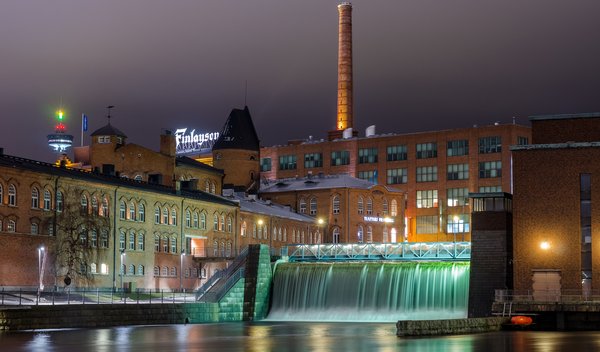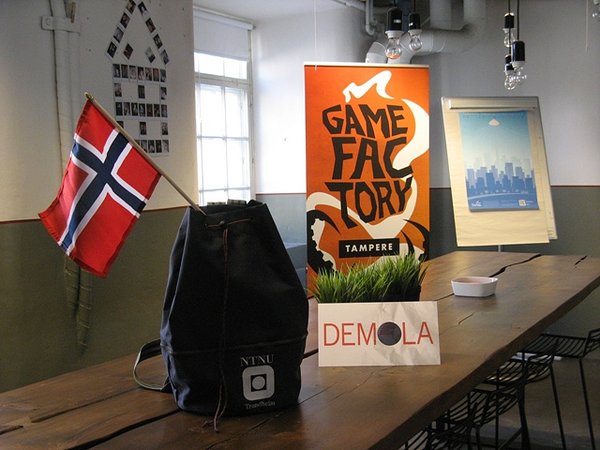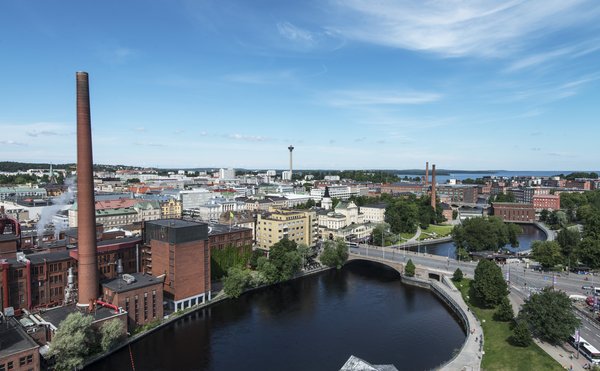Trondheim and Tampere universities of technology seek to gear up cooperation
24.9.2015The two Nordic cities of Trondheim and Tampere are “Twin Cities” since 1964. Not much concrete academic or business cooperation has seen light over the past 50 years, but now the ambition is to step up at least cooperation between their major universities. The cities share approximately the same population size, and the share of students out of it (close to 40 000 in both), which makes them vibrant innovation hubs, attracting national and international business interest.
The Tampere Region Economic Development Agency Tredea and Finpro, which helps Finnish SMEs go international and encourages foreign direct investment in Finland have together with Mid-Norway engaged in organising a joint long-term co-operation initiative to leverage activities around the Tampere-Trondheim Business Forum. The initiative also seeks to contribute to the nation-wide innovation policy brainstorming called Dream Commitment (Drømmeløftet), launched in Norway late 2014.
A charter flight from Trondheim brought representatives from the Norwegian University of Science and Technology (NTNU) to meet their Finnish colleagues at the Tampere University of Technology (TUT) on 15 September.
Discussions evolved around the current state of practice in commercialisation activities of university innovations and research results as well as best practices in creating new innovation ecosystems linking business and universities to boost the number of successful start ups.
The Norwegian delegation was lead by NTNU’s senior adviser, Morten Øien. The Finnish host for the day was TUT’s legal counsel Aapo Kiviniemi.
Joint R&D potential lies in complementary expertise and shared challenges
The rather informal talks quickly showed that there is a genuine willingness for cooperation, and that the two universities should get to know each other’s specific expertise and R&D interests better, in order to build complementary activities.
For example, whereas Finland is known to master mining technology, Norway has profound mastery when it comes to subsea installations with no people on them. In order to develop sound capacity to mine subsea, these two technologies have to be brought together.
According to Haakon Skar, CEO of the Trondheim-based T:Lab, a stepping stone in getting there [subsea mining] would be fully automated mines on land, which could serve as observation and learning platforms before fully automated mines subsea. Learning and testing for these types of installations need to be done on land, because if something goes wrong, a person can easily be sent to a mine on land to inspect and fix the problem, contrary to a situation when the mine is 700 meters sub-sea.
Common R&D interests linking the two Nordic universities could also stem from shared safety concerns linked to operating in hazardous environments where people can’t go and where robotics and the use of drones with specific mechanical features is clearly the only option. Examples of such hazardous environments are nuclear power plants before and after disaster and offshore installations with oil and gas that have caught fire or face other accident. Closing down facilities’ production for maintenance, sometimes for several days, and the related economic loss could also be avoided thanks to robotics.
More generally, an R&D centre having “departments focusing on different aspects of robotics, sensors and mechanical tools” could be an idea, Skar suggested.
A more organised cooperation on EU-funded projects would naturally also be a one of the first areas to look at to step up university cooperation. But for this to happen, people in both universities need to better know each other and each others’ specific areas of interest. Currently the cooperation happens more on an ad hoc basis and is initiated and lead by individual professors.
The Trondheim delegation also learned about the Finnish Metals and Engineering Competence Cluster (FIMECC), which is a strategic science, technology and innovation hub of the metal industry and mechanical engineering sectors.
Launched in 2008, this not-for profit and internationally open company already brings together the competence of 2200 people (with the administrative power of only seven people!) from the industry and academia to help strategic renewal of the sector.
In case Norway wants to build specific competence clusters operating through such an extraordinarily light administrative model, the CEO of FIMECC Harri Kulmala said he would be happy to share his knowledge with this regard.
Trondheim interested in the Finnish Demola innovation platform
The NTNU representatives together with Trondheim region and municipality representatives were also taken on a tour at the premises of the award-winning co-creation platform and space for university students, businesses and universities called Demola. (In Finnish the ending -la means a place. Demola thus stands for a place where demos are made.) The Tampere Demola is located at the very centre of the town.
Demola is an international organisation that has a rigorous operational model. A student can’t just come in and hang around, work space cannot be rented nor can companies just give money and leave. “In order to use Demola, you need to participate in a project,” explained Ville Kairamo, co-founder and the head of Demola. “Merely buying and selling resources is sub-contracting, not co-creation. Demola is not a cheap engine for subcontracting,” he underlined.
The Demola modus operandi consists of three rounds of three and a half months projects a year based on project ideas brought in by companies. Demola facilitates the design of projects and a call is opened for students to apply to be part of the projects. After a selection process, three to eight person teams formed by students from different universities and disciplines and business partners engage in an intensive co-creation process.
The project process is rigorous, each partner having a clear role and the Demola format ensuring that the work is systemic and runs on schedule. The minimum commitment from the business partners during the project is five hours per week. The work is guided by simple procedures and each project has an outcome – a new concept, a demo or a prototype.
According to the Demola preset agreements, students own the project results, so they have full rights to establish start-up companies and sell the rights to competitors based on them. Meanwhile, companies have one month after the project end to evaluate the result and decide whether they are going to utilize the results or not. If yes, they can purchase a non-exclusive patent or licence through paying a license fee to the students. “But as it is still non-exclusive, both parties can develop it further without too much limitations,” Kairamo noted.
More than 70% of all Tampere Demola project results have been licensed by the companies and the companies have created close to three million Euros (some 30 million NOK) in license fees for students over the years.
According to Tampere city business director Timo Antikainen, the city’s Demola is constantly “fully-booked” and the demand for Demola services is “ten times higher” than the supply. Sectors having used the platform include, for example, ICT, machine-building, banking, military, insurance, hospitals, cities and local bus companies.
An important factor attracting business interest in Demola is the fact that projects’ partner companies can easily licence or purchase the project outcome for further development because the concept has clearly defined models for legal requirements (contracts, intellectual property rights and licensing models) in place.
The concept’s innovation ecosystem is interdisciplinary, but also international: From the first Demola established in Tampere in 2008, the concept has rapidly expanded beyond the Finnish borders and Demola centres now operate in Sweden, Hungary, Lithuania, Latvia, Slovenia, Spain, Russia and Mexico. Further expansion plans, according to Ville Kairamo include, “hopefully” Norway, but also the UK, Portugal and a couple of Latin American countries.
Demola Netwok is thus creating a joint ecosystem operating similar and complementary models to create global platform for companies, students and researchers to co-create and participate in practical innovation work.
According to Kairamo, Demola is typically operated by a local or regional development company or a university’s Technology Transfer Office (TTO) in collaboration with the municipality and the universities in the region. To get things started and create critical mass, the first couple of years of a new centre are usually supported by public stakeholders such European regional fund, local municipality or, like in the case of Sweden, a government R&D funding agency (Vinnova).
Potential hosts for the Trondheim Demola could, according to Kairamo, be the NTNU’s Technology Transfer Office (TTO) or Technoport, which currently seeks to boost innovation through hosting various events bringing together researchers, business and investors. Kairamo was one of the keynote speakers at the 2015 Technoport event that took place in March.
“There is potential for collaboration between the innovation clusters of Trondheim and Tampere, and the Demola concept is one of them,” noted NTNU’s Morten Øien.
Seeking greater societal impact through a new university
Tampere and Trondheim are also both engaged in processes that will lead to profound structural change in their higher education sectors.
In a move that will make NTNU the biggest university in Norway, the NTNU board approved early 2015 a merger with the three university colleges surrounding it. The Ålesund University College (HiÅ), the Gjøvik University College (HiG) and the Sør-Trøndelag University College (HiST) specialize in maritime and information technology and business administration. The merger will increase the number of NTNU’s current 23 000 students to 38 000 and is expected to give an extra boost to research and technology development at the NTNU, strengthen regional and national innovation capacity, business and employment.
NTNU is currently the second largest of Norwegian universities. While it has the main national responsibility for higher education in engineering and technology, it also holds faculties in the natural and physical sciences, social sciences, the arts, medicine, architecture and fine art. The education is currently divided between the city centre science and technology campus of Gløshaugen and the Dragvoll campus of humanities and social sciences, five kilometres further on.
But the move of all Dragvoll activities (and its 14 000 students) around the Gløshaugen campus has just got official government backing. The gathering of all NTNU faculties in the city centre will be a huge investment, accompanied by high government expectations for the new setting to deliver on new knowledge, technology and expertise in a country that, according to its Prime Minister Erna Solberg, must prepare “for life without oil”.
The Tampere University of Technology (TUT) is Finland's second-largest university in engineering sciences. Now, in a similar development to that of Trondheim, it has together with Tampere city’s two other main higher education institutions, the University of Tampere (UTA) and the Tampere University of Applied Sciences (TAMK), engaged in merger discussions. The outcome would by far rival the recently established Aalto University – result of a merger between Helsinki’s engineering, business and arts schools – both in the number of students and in its interdisciplinary outreach.
The planned mergers both in Trondheim and Tampere will take years, and in Finland adoption of new laws is necessary to allow it to happen.
What is sure is that in order to deliver on societal challenges the mergers need to be accompanied by a serious planning and design effort to develop the new cross-disciplinary education programmes and content needed for the mergers to fulfil the ambition of a new university.
This article was first published in Trondheim's Meeting Place for Innovation - Technoport


